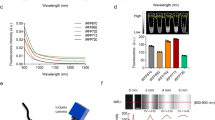Abstract
For current and future applications of human intestinal organoids (hIOs) to various aspects of in vivo research and their potential clinical use, an efficient noninvasive system is needed to directly visualize the stage of intestinal differentiation and graft–host interactions and for further safety monitoring and efficacy. Here, we describe a detailed method for monitoring and histologically identifying implanted hIO-expressing eGFP and mCherry fluorescence under the kidney capsule of immunodeficient mice with fluorescence imaging (FLI). We then describe the orthotropic transplantation method of hIOs and methods to confirm successful engraftment in the small intestines of immunodeficient mice. These methods provide an approach for tracking the location of intestinal cells in hIOs in vivo and ex vivo using a fluorescent reporter system from the beginning of engraftment to various subsequent experiments.
Access this chapter
Tax calculation will be finalised at checkout
Purchases are for personal use only
Similar content being viewed by others
References
Simons BD, Clevers H (2011) Stem cell self-renewal in intestinal crypt. Exp Cell Res 317:2719–2724
Noah TK, Donahue B, Shroyer NF (2011) Intestinal development and differentiation. Exp Cell Res 317:2702–2710
Van Der Flier LG, Clevers H (2009) Stem cells, self-renewal, and differentiation in the intestinal epithelium. Annu Rev Physiol 71:241–260
Mccracken KW, Howell JC, Wells JM et al (2011) Generating human intestinal tissue from pluripotent stem cells in vitro. Nat Protoc 6:1920–1928
Spence JR, Mayhew CN, Rankin SA et al (2011) Directed differentiation of human pluripotent stem cells into intestinal tissue in vitro. Nature 470:105–109
Sinagoga KL, Wells JM (2015) Generating human intestinal tissues from pluripotent stem cells to study development and disease. EMBO J 34:1149–1163
Fordham RP, Yui S, Hannan NR et al (2013) Transplantation of expanded fetal intestinal progenitors contributes to colon regeneration after injury. Cell Stem Cell 13:734–744
Fukuda M, Mizutani T, Mochizuki W et al (2014) Small intestinal stem cell identity is maintained with functional Paneth cells in heterotopically grafted epithelium onto the colon. Genes Dev 28:1752–1757
Yui S, Nakamura T, Sato T et al (2012) Functional engraftment of colon epithelium expanded in vitro from a single adult Lgr5(+) stem cell. Nat Med 18:618–623
Widjaja-Adhi MA, Lobo GP, Golczak M et al (2015) A genetic dissection of intestinal fat-soluble vitamin and carotenoid absorption. Hum Mol Genet 24:3206–3219
Chen C, Benjamin MS, Sun X et al (2006) KLF5 promotes cell proliferation and tumorigenesis through gene regulation and the TSU-Pr1 human bladder cancer cell line. Int J Cancer 118:1346–1355
Jung KB, Lee H, Son YS et al (2018) In vitro and in vivo imaging and tracking of intestinal organoids from human induced pluripotent stem cells. FASEB J 32:111–122
Finkbeiner SR, Hill DR, Altheim CH et al (2015) Transcriptome-wide analysis reveals hallmarks of human intestine development and maturation in vitro and in vivo. Stem Cell Reports 4:1140–1155
Watson CL, Mahe MM, Munera J et al (2014) An in vivo model of human small intestine using pluripotent stem cells. Nat Med 20:1310–1314
Son MY, Kwak JE, Seol B et al (2015) A novel human model of the neurodegenerative disease GM1 gangliosidosis using induced pluripotent stem cells demonstrates inflammasome activation. J Pathol 237:98–110
Jung KB, Kwon O, Lee MO et al (2019) Blockade of STAT3 causes severe in vitro and in vivo maturation defects in intestinal organoids derived from human embryonic stem cells. J Clin Med 8:E976
Jung KB, Lee H, Son YS et al (2018) Interleukin-2 induces the in vitro maturation of human pluripotent stem cell-derived intestinal organoids. Nat Commun 9:3039
Acknowledgments
This research was supported by the National Research Foundation of Korea (NRF) grant funded by the Korean government (MSIT) (NRF-2018M3A9H3023077) and a grant from the KRIBB Research Initiative Program.
Author information
Authors and Affiliations
Corresponding author
Editor information
Editors and Affiliations
Rights and permissions
Copyright information
© 2020 Springer Science+Business Media, LLC, part of Springer Nature
About this protocol
Cite this protocol
Lee, H., Son, MY. (2020). Using Bioengineered Fluorescence for Selective In Vivo and Ex Vivo Tracking of Intestinal Organoids Derived from Human Pluripotent Stem Cells. In: Basel, M., Bossmann, S. (eds) Cell Tracking. Methods in Molecular Biology, vol 2126. Humana, New York, NY. https://doi.org/10.1007/978-1-0716-0364-2_6
Download citation
DOI: https://doi.org/10.1007/978-1-0716-0364-2_6
Published:
Publisher Name: Humana, New York, NY
Print ISBN: 978-1-0716-0363-5
Online ISBN: 978-1-0716-0364-2
eBook Packages: Springer Protocols




